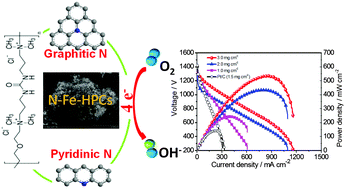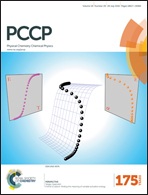The design of Fe, N-doped hierarchically porous carbons as highly active and durable electrocatalysts for a Zn–air battery
Abstract
A new type of Fe, N-doped hierarchically porous carbons (N–Fe-HPCs) has been synthesized via a cost-effective synthetic route, derived from nitrogen-enriched polyquaternium networks by combining a simple silicate templated two-step graphitization of the impregnated carbon. The as-prepared N–Fe-HPCs present a high catalytic activity for the oxygen reduction reaction (ORR) with onset and half-wave potentials of 0.99 and 0.86 V in 0.1 M KOH, respectively, which are superior to commercially available Pt/C catalyst (half-wave potential 0.86 V vs. RHE). Surprisingly, the diffusion-limited current density of N–S-HPCs approaches ∼7.5 mA cm−2, much higher than that of Pt/C (∼5.5 mA cm−2). As a cathode electrode material used in Zn–air batteries, the unique configuration of the N–Fe-HPCs delivers a high discharge peak power density reaching up to 540 mW cm−2 with a current density of 319 mA cm−2 at 1.0 V of cell voltage and an energy density >800 Wh kg−1. Additionally, outstanding ORR durability of the N–Fe-HPCs is demonstrated, as evaluated by the transient cell-voltage behavior of the Zn–air battery retaining an open circuit voltage of 1.48 V over 10 hours with a discharge current density of 100 mA cm−2.



 Please wait while we load your content...
Please wait while we load your content...